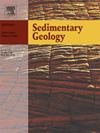Residual beachrock and coastal eolianite patches without anthropogenic components on the eastern coast of Cantabria (Spain)
IF 2.9
2区 地球科学
Q1 GEOLOGY
引用次数: 0
Abstract
Isolated beachrocks appear as relict patches normally attached to protrusions of lower-upper Cretaceous limestones outcropping at Noja, Somo and Sonabia zones in the eastern coast of Cantabria (northern Spain). Additionally, remnant cemented dunes (eolianites) are present at different heights above present sea level. We concentrate on the petrographic features of first-generation cements, that are different in the lower foreshore and upper foreshore-backshore. δ13C and δ18O values measured in the cements of both beachrock and eolianite suggest mixing between marine and meteoric waters, generally with preponderance of the continental contribution. In all the studied examples, Coccus-type bacterial activity has been recognized, suggesting that it is the main trigger for the initiation of cementation. 14C dating shows that the different cementations studied did not occur in a single event at a specific age, since there is a notable variation, from the highest values of 8760 years BP to 2740 years BP, despite the beachrock patches being at the height of the current intertidal zone. In the non-cemented intertidal sands that form the current beaches there are also important variations, difficult to justify, from similar ages of 3050 years BP (Noja) and 3010 years BP (Somo) to a mere 390 years BP (Sonabia).
西班牙坎塔布里亚东海岸无人为成分的残留滩岩和海岸风成岩斑块
在坎塔布里亚(西班牙北部)东海岸的Noja、Somo和Sonabia地区,孤立的滩岩通常是附着在上白垩纪石灰岩突出物上的遗存斑块。此外,残存的胶结沙丘(风成岩)存在于当前海平面以上的不同高度。重点研究了第一代胶结物的岩石学特征,它们在下前滨和上前滨-后滨具有不同的特征。在滩岩和风成岩胶结物中测量的δ13C和δ18O值表明海洋和大气水混合,通常以大陆贡献为主。在所有研究的例子中,已经确认了球菌型细菌活性,这表明它是开始胶结的主要触发因素。14C测年表明,所研究的不同胶结作用并非发生在一个特定年龄的单一事件中,因为尽管滩岩斑块处于当前潮间带的高度,但从8760年BP到2740年BP的最大值存在显著变化。在形成当前海滩的非胶结潮间带砂中也有重要的变化,很难证明,从类似的3050年BP (Noja)和3010年BP (Somo)到仅仅390年BP (Sonabia)。
本文章由计算机程序翻译,如有差异,请以英文原文为准。
求助全文
约1分钟内获得全文
求助全文
来源期刊

Sedimentary Geology
地学-地质学
CiteScore
5.10
自引率
7.10%
发文量
133
审稿时长
32 days
期刊介绍:
Sedimentary Geology is a journal that rapidly publishes high quality, original research and review papers that cover all aspects of sediments and sedimentary rocks at all spatial and temporal scales. Submitted papers must make a significant contribution to the field of study and must place the research in a broad context, so that it is of interest to the diverse, international readership of the journal. Papers that are largely descriptive in nature, of limited scope or local geographical significance, or based on limited data will not be considered for publication.
 求助内容:
求助内容: 应助结果提醒方式:
应助结果提醒方式:


